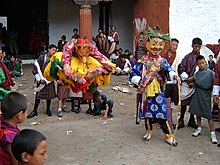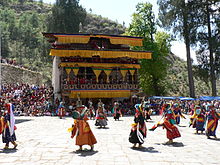Tsechu
Tsechu ( dzongkha ཚེས་ བཅུ ། day ten ) denotes annual religious festivals in each district ( Dzongkhag ) of Bhutan , which always take place on the tenth day of a month of the Tibetan calendar . The month varies depending on the location. Tsechus are religious festivals of the Drugpa Kagyu of the Kagyu school of Tibetan Buddhism .
Tsechus are also large popular assemblies that bring together people from remote and distant villages. Large markets arise at the location where the action is taking place, leading to brisk trade. The festivals in the capital Thimphu and Paro are among the largest Tsechus in participants and spectators .
Traditions
The Cham mysteries are at the center of the Tsechus . These dances, performed in costumes and masked, typically show magical incantations or are based on events from the life of the Nyingma teacher Padmasambhava (9th century) and other saints.
Most of the Tsechus also involve rolling up a so-called thongdrel - a large scroll painting ( thangka ) with silk appliqués, which usually shows the seated Padmasambhava surrounded by his manifestations ; the mere sight of the picture is supposed to cleanse the viewer of his sins. The thongdrel is unrolled before dawn and rolled up again the following morning.
Because the festivities depend on the availability of masked dancers, registered dancers can be penalized if they refuse to attend such a dance.
history
Padmasambhava , the great scholar, visited Tibet and Bhutan in the 8th and 9th centuries. He promoted the conversion of opponents of Buddhism with the help of rites, mantras and dances with which he tried to subdue spirits and gods. The reason for the trip to Bhutan was to help the dying King Sindhu Raja . Padmasambhava performed a series of such dances in the Bumthang Valley to restore the king's health. Out of gratitude, he helped him to spread Buddhism in his kingdom. Padmasambhava organized the first tsechu in Bumthang , where his eight revelations were presented through eight dance forms. These became the Cham mysteries , which are said to represent Padmasambhava's glory.

program
The sequence of the dances for each of the four days is fixed and generally consists of the following dances.
- On the first day these performances take place: Dance of the four deer (Sha Tsam) ; Dance of the Three Children Gings (Pelage Gingsum) ; Dance of heroes (pacham) ; Deer and Hound Dance (Shawo Shachi) ; Dance with the Dran-nye (Dranyeo Cham)
- The following performances take place on the second day: Dance of the Black Hat (Shana) ; Dance of the 21 black hats with drums (Sha nga ngacham) ; Dance of the Nobles and Ladies (Pholeg Moleg) ; Dance of Dramitse's Drums (Dramitse Ngacham) ; Dance of the Deer and Hounds (Shawo Shachi)
- The third day follows: Dance of the Lords and Cremation Places (Durdag) ; Dance of the Terrifying Deities (Tungam) ; Dance of the Rakshas and Judgment of the Dead (Ragsha Mangcham)
- On the last day there will be final performances: Dance of the Tamzhing Monastery in Jakar ; Dance of the Lords and Cremation Places (Durdag) ; Dance of the Ging and Tsoling (Ging Dang Tsoling) ; Dance of the eight revelations of Padmasambhava (Guru Tshen Gye)
On the last day of the festival, the thongdrel , combined with intense religious fervor, is rolled out early in the morning. The painting measures 30 × 45 meters and, as mentioned, shows Padmasambhava in the center, flanked by his two wives Llacham Mandarava and Yeshe Tsogyal and the eight revelations. Devotees who gather to watch the event pay homage to the image for blessings. Folk dances accompany the ceremony. Before sunrise, the painting is rolled up again and will remain in the dzong until the next year .
Popular culture
The Bhutanese film Of Travelers and Magicians is about a group of travelers, the majority of whom visit the Tsechu in Thimphu.
Individual evidence
- ↑ Elaine Dobson: Dancing on the demon's back: the dramnyen dance and song of Bhutan . University of Western Australia July 2003.
- ^ Bhutan Observer, "Reluctant mask dancers. October 4, 2012, accessed November 10, 2018 .
- ↑ Palin . S. 269-270 .


